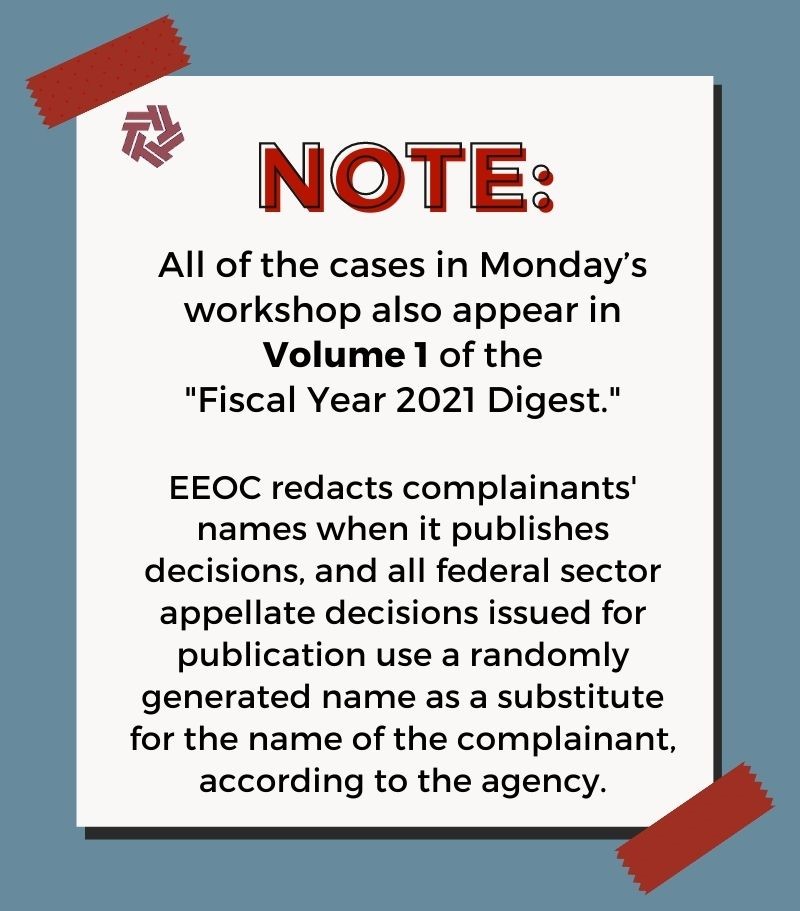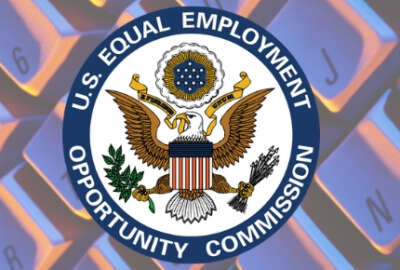EEOC reminds federal managers how to avoid common complaints
Attorney Elyssa Santos-Abrams hosted the Equal Employment Opportunity Commission's latest Federal Sector Case Update workshop for attorneys, mediators, human...
Editor’s Note: This story has been updated with the correct time limit for federal employees to contact an agency equal employment opportunity counselor. The original version of this story also incorrectly described the case of Alfonso C. v. Dept. of the Army.
Not that federal regulators would recommend it, but if a federal supervisor wants to get hit with a retaliation complaint, a sure fire way to do so would be to downgrade an employee’s performance review right after they file an equal employment opportunity complaint.
And yet, that’s exactly what happened to a civil service mariner in the Department of the Navy last year, a case which that employee ultimately won.
It’s an example of the different ways EEOC determines retaliation decisions at government agencies, according to attorney Elyssa Santos-Abrams. She highlighted several different cases from 2020 and 2021 during Monday’s virtual Federal Sector Case Update workshop to help attorneys, mediators, human resource personnel, union officials and equal employment opportunity professionals better understand topics such as retaliation, timeliness of filing EEO actions, harassment, discrimination and “rehabilitation” or medical or disability workplace accommodations.
 When it comes to retaliation specifically, Santos-Abrams said a big part of EEOC decisions is whether or not the actions taken by managers could create a chilling effect and dissuade employees from coming filing complaints in the future. She offered two cases from the Department of the Navy as examples.
When it comes to retaliation specifically, Santos-Abrams said a big part of EEOC decisions is whether or not the actions taken by managers could create a chilling effect and dissuade employees from coming filing complaints in the future. She offered two cases from the Department of the Navy as examples.
In the case of Mitizie W. v. Dept. of the Navy from March of last year, a mariner reported being stalked and harassed — by an enlisted seaman onboard the ship where they worked — to her second- and fourth-level supervisors who had previously called her an “excellent” and “outstanding” employee. But after she complained, the second-level supervisor directly mentioned her intention to undertake EEO activity in her next performance review. The two reviews, written mere months apart, went from calling the mariner “amazing … basically on every level,” to “a slow learner” who threatened supervisors with EEO action, Santos-Abrams said.
“So when I say you don’t do that, I really mean, you do not do that, OK?” she said. “Having someone’s EEO activity mentioned in a performance review, is clearly enough to deter that person or other people from engaging in the EEO process. And that is what retaliation really is all about.”
In the case of Irene M. v. Dept. of the Navy from February, after the employee made a sex-based harassment complaint, supervisors had conversations about her performance within earshot in an open office, lowered her performance evaluation and made intimidating comments including questions about her intentions to stay at the organization.
“If you’re threatening to discipline someone, you’re giving them a poor performance appraisal, even if you later change the score — that threat alone of that negative action would be enough to deter someone from filing an EEO complaint or otherwise engaging in the EEO process, which is what happened here,” Santos-Abrams said.
‘Timeliness’ can cause EEO confusion for managers
A common source of federal manager missteps stems from employees’ timeliness of filing EEO complaints. EEOC resources state that federal employees and applicants should contact an EEO counselor at the agency within 45 calendar days of the discriminatory action.
The case of Emelda F. vs. Department of the Army in May 2020 had a complainant who said she was denied a pay raise and back pay. Santos-Abrams said the Lilly Ledbetter Fair Pay Act states that every improper paycheck begins a 45-day timeframe in which to file a claim.
“So while the agency argued that her reasonable suspicion of this pay raise should have occurred more than 45 days before she contacted a [EEO] counselor, whether or not to develop that reasonable suspicion at the earlier time is irrelevant — because each paycheck starts a new 45-day clock,” she said. “And what we see is that agencies make that mistake quite often.”
Who counts as a fed under ‘joint’ employment?
Another EEO area that confuses managers is that of joint employment or contract work. Sometimes complaints arise because managers do not realize contractors are eligible for the federal EEOC process. In the case of Alfonso C. v. Dept. of the Army in December, the complainant was employed by a third-party staffing firm and advising NATO security forces in Afghanistan. His claim of racist statements perpetrated by a coworker was dismissed because he was a contractor.
On the contrary, Santos-Abrams said, when the agency is largely responsible for setting that worker’s schedule, assigning daily tasks, reviewing their work and they work on agency premises with agency equipment — that’s enough to establish joint employment. It’s not enough to just look at the contract language, she said.
“What we’re looking at, it’s more of like a holistic sort of approach, we’re looking at the control, how much control does the federal government exercise over this particular employee?” she said. “And it’s not like a checklist … if we had 13 factors or 14 factors, and you meet eight of those, then you’re automatically jointly employed at federal government — it’s about what is actually happening in the workplace.”
Workplace accommodations demand closer look in the COVID era
Even before the COVID-19 pandemic, EEO complaints related to workplace accommodations under the Rehabilitation Act were fairly common because supervisors did not check with their own agency’s policy, agency attorneys or EEOC staff before making decisions that open the door for liability.
Santos-Abrams pointed to the case of a postal worker who was denied a sign language interpreter for a Combined Federal Campaign event — ironically an event for networking with fed-focused charities. This was despite the fact that resource organizations existed to provide information in this area, even for smaller agencies that had not worked with hearing-impaired employees before.
“And there was no attempt by the agency to discuss alternative options such as video remote interpreting or video relay services, which could be just part of the kind of accommodations that are regularly used by an agency. This is not anything novel, this is not anything unusual,” she said.
She also cited a case of an agency not securing a sign language interpreter for an employee at an emergency meeting about possible COVID-19 exposure.
As vaccination mandates go into effect for employees, the question of medical information disclosures and what’s allowed under EEOC rules could be a landmine for managers. As such, EEOC published COVID-specific Rehabilitation Act compliance advice on its website.
Copyright © 2025 Federal News Network. All rights reserved. This website is not intended for users located within the European Economic Area.
Amelia Brust is a digital editor at Federal News Network.
Follow @abrustWFED





